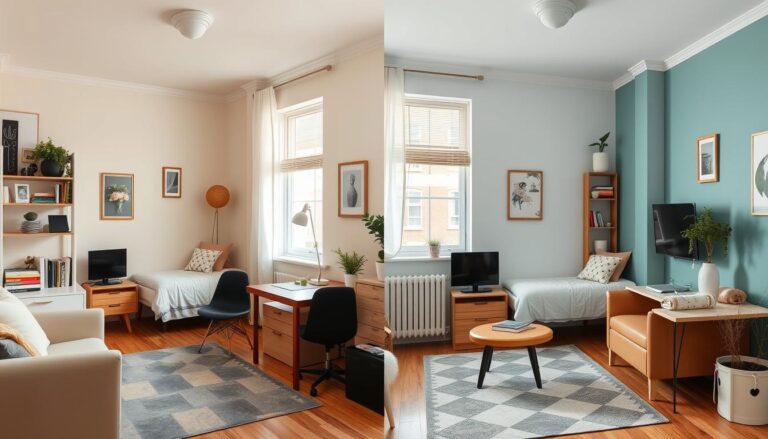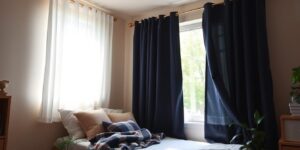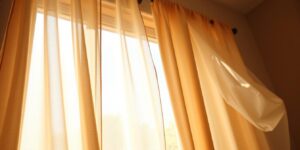10 student-friendly headboard ideas you can make in one afternoon
Get inspired with 10 student-friendly headboard ideas that are easy to make in one afternoon. Perfect for dorm rooms.
Upgrading your bedroom doesn’t require deep pockets or weekends of work. With simple materials and a dash of creativity, you can craft eye-catching focal points for your bed in just a few hours. These projects prove style and practicality aren’t mutually exclusive – especially when repurposing items like wooden shims or vintage shutters.

Busy schedules demand solutions that deliver maximum impact with minimal effort. That’s why each design here skips complex tools in favor of accessible techniques. Whether using fabric remnants or upcycled pallets, you’ll learn to create polished looks that mirror high-end furniture stores.
Best part? Most materials cost less than a pizza night. Forget sacrificing personality for affordability – these ideas let you customize dimensions, colors, and textures to match your unique space. Many students have already transformed dorms and apartments using these exact methods.
Key Takeaways
- Complete stylish upgrades in one afternoon
- Use affordable materials like wood scraps or fabric remnants
- Avoid power tools with beginner-friendly techniques
- Personalize designs to match existing decor
- Save money compared to store-bought alternatives
- Enhance small spaces without permanent changes
Introduction to Student-Friendly Headboard Ideas
Creative decor solutions are reshaping how young adults approach compact living areas. Social media platforms now serve as virtual workshops where renters share innovative techniques for temporary spaces. Pinterest boards and Instagram Reels demonstrate how basic materials transform bland walls into personalized retreats.
Social Media’s Design Revolution
Visual platforms have erased traditional barriers to interior design. Tutorials using thrifted fabrics or repurposed wood scraps empower anyone to craft professional-looking pieces. These projects require minimal tools while delivering maximum visual impact.
Adapting to Temporary Spaces
University housing often comes with strict rules and limited budgets. Removable upgrades solve two problems: personalizing rooms without security deposit risks and creating adaptable systems for frequent moves. Studies show organized, customized environments improve focus by up to 18% during study sessions.
What Else Would You Like to Know?
Choose below:
Practical designs also address spatial constraints. Many students use:
- Lightweight foam boards wrapped in fabric
- Interlocking wooden panels
- Magnetic curtain rods with hanging textiles
These approaches let renters express individuality while respecting lease agreements. The right bedroom upgrade becomes both artistic outlet and functional anchor in transitional living situations.
Benefits of DIY Headboards for Dorm Rooms

Custom bed accents transform bland dorm rooms into cozy retreats without breaking rental agreements. A well-designed piece adds vertical interest to basic furniture, masking institutional vibes with texture and color. It’s like hanging artwork that doubles as functional support – perfect for late-night study sessions against pillows.
Practical perks matter when living in tight quarters. Sturdy designs cushion your back during marathon textbook readings, while lightweight materials prevent wall damage. Most projects cost under $50 compared to $200+ store-bought versions – savings that add up during college years.
Personalization shines through fabric choices, paint colors, or unexpected materials like woven baskets. Tailor dimensions to twin XL beds common in campus housing, or create modular pieces that adapt to future apartments. These projects teach measuring and assembly skills that outlast dorm life.
Completing a hands-on upgrade builds confidence between exams and deadlines. As one recent grad noted: “My floral-patterned creation became my room’s focal point – and proof I could tackle adult projects.” That sense of achievement fuels motivation in other areas too.
Choosing the Right Materials
Smart material choices elevate DIY projects from basic to brilliant without draining your wallet. Focus on versatile components that adapt to rental rules while reflecting personal style. Three factors matter most: cost, compliance with housing policies, and compatibility with your bed frame.
Wood, Fabric, and Found Items
Wood shims outperform pricey lumber for custom pieces. Arrange them vertically for a modern slat effect or horizontally for rustic charm. Pair with $5 sample paint pots from hardware stores for bold accents.
Fabric transforms spaces faster than permanent options. Canvas drop cloths mimic linen at a fraction of the cost. Look for remnant bins at craft stores – oversized prints hide seams in oversized designs.
Scour flea markets for:
- Vintage shutters (ideal twin bed size)
- Picture frames with intricate molding
- Decorative metal grates
Understanding Dorm Limitations
Most campuses ban nails and heavy wall anchors. Opt for lightweight foam core boards or interlocking panels that lean against furniture. Fire-retardant fabrics prevent safety violations – check tags before purchasing.
Modular designs simplify moves between dorms. A recent survey found 63% of students reuse projects when materials weigh under 15 pounds. Measure your space twice: standard twin XL beds need 39-inch widths.
Thrift stores often stock unused upholstery fabric. As one RA advises: “Temporary solutions should leave walls cleaner than you found them.” Removable adhesive strips prove wiser than duct tape for fabric installations.
Step-by-Step DIY Techniques
Efficiency meets creativity in these streamlined assembly methods. With proper preparation, you’ll transform basic materials into bedroom showstoppers faster than streaming three sitcom episodes. Focus on three core elements: precise measurements, smart tool use, and adaptable attachment solutions.
Essential Tools and Supplies
Start with these dorm-friendly basics:
- Tape measure & carpenter’s square
- Hand saw or borrowed miter saw
- Wood glue & removable mounting strips
- Sandpaper (120-220 grit)
Many campuses offer tool rentals – check bulletin boards near laundry rooms. For the casing pattern project, cut plywood to your bed’s exact width first. Alternate painted and natural wood strips for visual depth without complex joinery.
Easy Assembly Tips
Mark cutting lines with painter’s tape to prevent splintering. When angling casing pieces, cut one test strip before committing to all materials. “Rushing leads to redoing work – measure twice, glue once,” advises DIY workshop coordinator Mara Lin.
Secure trim with adhesive-backed hooks if drilling isn’t allowed. For uneven walls, use foam board shims behind the frame. Complete projects faster by pre-cutting materials during study breaks and assembling during free hours.
Budget-Friendly DIY Headboard Ideas
Your dream bed backdrop might be hiding among unused household objects. With resourcefulness, you can craft striking designs using materials costing less than a week’s coffee budget. These projects turn overlooked items into functional art while keeping landfills emptier.
Low-Cost Materials and Upcycling
Scout campus freebie piles for picture frames needing fresh look. Stack three vertical frames over your bed, painting each a different accent color. For texture, wrap old textbooks in kraft paper and arrange them geometrically.
Dorm move-out days yield treasures. One student transformed curtain rods into a nautical-inspired piece: “I tied rope between two rods using sailing knots – total cost $12.” Carpet tiles work too – adhere them to foam board with removable glue dots.
Repurposing Household Items
Wooden hangers become instant wall art when arranged in sunburst patterns. Test structural integrity by hanging a backpack on your creation overnight. Fabric scraps gain new life as patchwork panels – clip them to tension rods for easy swaps.
Consider these unexpected materials:
- Woven laundry baskets (cut backs off)
- Vinyl record collections
- Interlocking foam floor tiles
Always check fire safety ratings before installing. Most projects take 90 minutes or less – perfect between study sessions. As sustainability advocate Jamie Chen notes: “Beautiful spaces shouldn’t cost the earth – literally or financially.”
Inspiring Designs from Home Center and Pinterest
Social media platforms overflow with inventive bedroom transformations that spark creativity. By blending salvage materials with modern techniques, you can replicate high-end aesthetics using basic tools and thrifted finds.
Creative Wood and Shutter Inspirations
Reclaimed shutters make striking focal points when mounted horizontally above your bed. Sand rough edges lightly, then paint with chalk finish for a weathered look. Pair two shutters side-by-side for queen beds, securing them with L-brackets to a plywood frame.
Try these budget-friendly upgrades:
- Stencil geometric patterns on barn wood planks
- Attach crown molding to home center shutters
- Layer fabric panels behind slatted frames
Distressing techniques add instant character. Rub dark wax over white paint using a rag, focusing on edges. For smaller spaces, cut shutters to twin XL dimensions. “My shutter piece got 900 repins by lunchtime,” shares University of Texas junior Clara Reyes.
Photograph your creation in natural light against neutral walls. Use free editing apps to adjust brightness before posting. Remember – removable adhesive strips keep installations dorm-safe while letting your design shine.
Headboard Ideas Featuring Wall Hangings and Tapestries
Transform blank walls into dramatic focal points using textiles that require zero construction. This approach lets renters achieve high-impact style without violating dorm policies or leaving permanent marks. Textile installations adapt to any bed size and can be swapped faster than changing your playlist.
Tapestry and Curtain Inspired Designs
Drape lightweight fabrics from a tension rod mounted just below the ceiling. For rustic charm, sand birch branches and secure them with heavy-duty hooks. Choose patterns that contrast with bedding – geometric prints pop against solid-colored sheets.
Layering creates depth. Hang a sheer curtain behind a bold tapestry using removable strips. “I used two overlapping tapestries to make my twin bed feel like a king,” shares UCLA sophomore Diego Martinez. Rotate designs seasonally – floral prints for spring, warm plaits for winter.
DIY Wall Decals and Art Pieces
Turn fabric remnants into custom artwork with stencils and fabric paint. Stretch material over foam boards using double-sided tape. For 3D effects, attach woven baskets or paper lanterns around your creation.
Create optical illusion with vertical stripes or arched shapes. Position pieces 6-8 inches above the mattress for proportional balance. Most projects take under an hour and cost less than a movie ticket.
Key considerations:
- Use fire-retardant fabrics near beds
- Test adhesive strength on walls first
- Align patterns with pillow arrangements
Creative Use of Fabric and Upholstery
Textile transformations offer endless possibilities for refreshing your sleep space. With simple swaps and clever layering, you can achieve luxury hotel vibes using materials already in your closet. This approach works particularly well for renters needing temporary solutions that adapt to evolving styles.
DIY Slipcovers and Reupholstering
Old curtains or bedsheets become instant upgrades with basic sewing skills. Drape fabric over existing panels, securing edges with removable adhesive strips. For tufted designs, mark diamond patterns and thread buttons through batting layers. Pro tip: Use contrasting thread colors to highlight geometric shapes.
Thrift store finds shine with fresh upholstery. Staple gun new fabric over chair pads or foam boards, wrapping edges neatly. Mix textures like velvet and linen for visual interest. Coordinate your creation with throw pillows in complementary hues.
Carpet and Batting Techniques
Discarded carpet tiles make surprisingly plush backdrops. Arrange squares in checkerboard patterns using double-sided tape. For added depth, layer quilt batting behind sheer drapes. This creates a cloud-like effect perfect for leaning against during late-night study sessions.
Combine techniques by wrapping foam boards in batting before adding fabric covers. Secure with decorative nails or ribbon ties. These soft-touch designs blend seamlessly with existing bedding while protecting walls from scuffs. As one designer notes: “Fabric projects let you experiment fearlessly – mistakes become design features.”
FAQ
How can I make a headboard without damaging dorm walls?
What materials work best for DIY projects in small spaces?
Are there budget-friendly options for custom designs?
What tools do I need for a basic build?
How do I add storage to a headboard?
Can I create a temporary design for rented spaces?
What fabrics hold up well in high-use areas?
Where can I find design inspiration quickly?
How long does a typical DIY project take?
Can I personalize a headboard without paint?
The Best Colors to Make Your Student Apartment Feel Bigger
» See exclusive tips for your home








